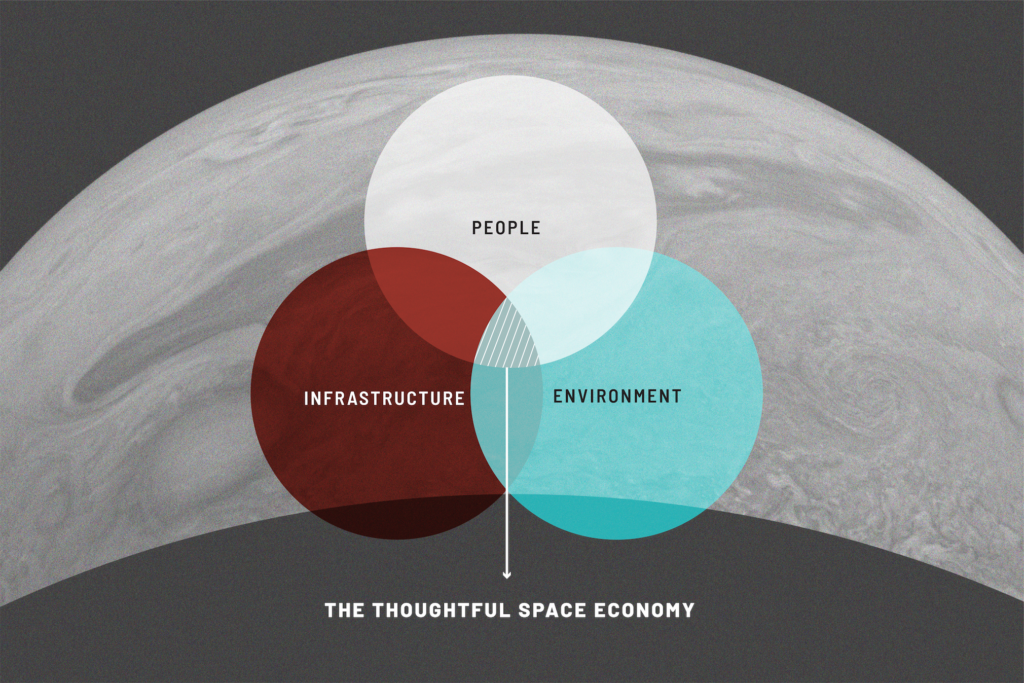The global space economy is currently valued at about $350 billion and is estimated to reach $1 trillion or more by 2040. Insiders say the “revolution that is commercial space is just beginning,” and investors are taking notice. Morgan Stanley held its first space summit late last year, and said 2019 could be “the year for space.”
Space is widely seen as a new frontier for exploration, but we’ve gone through periods of exploration before. Past ages of exploration created opportunities for some, but certainly not all; those laying the groundwork for near-term infrastructure and rewards didn’t always consider long-term growth or consequences. How can we avoid the mistakes of the past and make the space economy more equitable and sustainable?
What is the “space economy”?
The original space industry was centralized, national, and aspirational; it was essentially limited to state-run programs and public-private partnerships. The new space economy is decentralized, entrepreneurial, and accessible; it’s increasingly diversified and includes players across industries.
We’re particularly interested in what it will take to build a thoughtful space economy that considers the connection between people, infrastructure, and environment.
How we got here
Throughout history, humans have looked up to the stars with curiosity. We’ve long desired to understand space, but the reality of extraterrestrial exploration has evolved significantly in recent decades. The 20th century saw the rise of national, centralized space programs, fueled in part by an intense rivalry between the United States and the Soviet Union:
“Both countries gave primary emphasis in their space efforts to a combination of national security and foreign policy objectives, turning space into an area of active competition for political and military advantage” (NASA)
In the 21st century, public-private partnerships and private investment have prompted a shift toward more decentralized, private sector exploration. Government space agencies like NASA have long collaborated with private companies to advance space technology. In the United States, the Communications Satellite Act of 1962 paved the way for a commercial communications satellite system; the Commercial Space Launch Act of 1984 went even further, requiring NASA to “seek and encourage, to the maximum extent possible, the fullest commercial use of space.” By 2010, nearly one-third of worldwide space launches were commercial.
In the past decade, a sharp rise in entrepreneurial “New Space” firms — emerging aerospace companies promoting lower-cost access to space — have sparked new conversations about the commercialization and “democratization of space.” And this month, NASA opened applications for its first space accelerator, designed for both “New Space” companies and tech startups in other industries. Unsurprisingly, growth in space entrepreneurship has been met with an explosion of capital:
“According to leading space industry analyst Bryce Space and Technology (2017), outside investment in startup New Space firms has risen from less than $500 million per year from 2001 to 2008 to roughly $2.5 billion per year in 2015 and 2016. … The shift from public to private priorities in space is especially significant because a widely shared goal among commercial space’s leaders is the achievement of a large-scale, largely self-sufficient, developed space economy.” (Journal of Economic Perspectives)
Space is a large and rapidly growing opportunity for organizations in many industries — from navigation and meteorology to disaster relief and agricultural planning — and as NASA’s Gary Martin has pointed out, “the established state-run industrial space sector is no longer the only game in town.”
The world’s first active communications satellite was funded by AT&T in 1962; today, OneWeb is building a global constellation of low Earth orbit satellites with goals to offer global “5G ready” internet coverage by 2021. Meanwhile, industry applications are expanding far beyond telecommunications: Virgin Galactic and Blue Origin want to make suborbital flights a reality in the tourism industry. Manufacturers are making launch equipment on Earth and bringing additive manufacturing to low-earth orbit. The U.S. Geological Survey is evaluating the possibilities for mining water, minerals, and minerals in space, and a recent report details what it would take to extract water from the Moon.
What’s at stake
As the space economy expands to include new industries and investments, we’re facing important questions about sustainability, ethics, and equity.
Space mining — on asteroids, the Moon, or another planet — is less far-fetched than it sounds, and two companies plan to launch prospecting missions in 2020. International space treaties and policies don’t yet account for the potential environmental, economic, and political disruptions space mining could bring.
As access to space becomes more decentralized and affordable, timelines to launch shorten and more objects enter space. Millions of pieces of orbital debris, or “space junk,” pose a real threat to spacecraft. Current guidelines may not be enough to keep space free of a dangerous trash pile-up; the FCC is seeking public comment on revising its orbital debris guidelines.
The functioning satellites in space are looking out to space or looking down on Earth, collecting and transmitting data. Data privacy and data ethics are already complicated issues on Earth, and become even more difficult to navigate in space. Satellites can monitor life on Earth in high-resolution detail, allowing us to better understand “patterns of life” but “also provoking concerns about the erosion of personal privacy and national sovereignty, as private companies and individuals gain insights into our world that were once mostly the preserve of governments and their agencies. All of us are increasingly exposed under the eye in the sky.”
We want the benefits of information, but haven’t come to terms with the loss of privacy, and haven’t fully engaged in the public discourse required to create thoughtful infrastructure and standards for data ethics and data privacy. At the same time, if infrastructure in space — including data, hardware, and other technology — isn’t designed for interoperability, collaboration will be inefficient, and in some cases, impossible.
Bringing diverse perspectives to discussions about sustainability, ethics, and infrastructure can go a long way toward anticipating and mitigating risk. Across the STEM workforce, women, African-Americans, and Hispanics are underrepresented and earn less than their white male and Asian-American male counterparts. NASA’s strategic plan for diversity and inclusion recognizes the need to “educate a more diverse American public” and “increase outreach efforts to encourage and motivate people, especially young people (the ‘Mars Generation’), in diverse and underserved communities to pursue careers in STEM.”
As the space industry evolves into a larger space economy, jobs in space expand beyond astronauts and engineers to include everything from science and communications to product development and hospitality. The Office of Space Commerce has identified the development and availability of talent as a key factor impacting growth of the space economy. Without equitable access to education and workforce development opportunities, the benefits of a $1 trillion space economy won’t be available to everyone.
Potential solutions
What are the ethics of exploration? While many nations have voluntarily signed the United Nations’ space treaties, the agreements are nonbinding and private entities may not even be covered. Space law is evolving and legal jurisdiction in space is unclear; we can’t even decide exactly where Earth’s atmosphere ends and space begins. Major areas of debate include debris, mining, property rights, international cooperation, and access to space — and as the space economy grows, that list of concerns will grow along with it.
Building a thoughtful space economy requires us to consider how decisions impact people, infrastructure, and the environment.
People
Who benefits? Who’s at risk? How do we champion equality and access in this new age of exploration and avoid the exploitative mistakes of past ages of exploration? What does justice look like on the space frontier?
The thoughtful space economy should expand access and ensure equity. We already know companies with greater leadership diversity are more profitable; likewise, an inclusive space economy will be more robust and benefit more people. Access to STEM programs and other educational opportunities can help diversify participation in the space economy, and we’re watching these initiatives with interest:
- Student-run experiments. DreamUp, in partnership with aerospace company NanoRacks, encourages students to design space-based experiments on the International Space Station through the use of cost-effective kits. Because Learning’s Ardusat Space Program, in partnership with space data and analytics company Spire, empowers students to design and run experiments using space data from satellites.
- SmallSats in schools. Irvine CubeSat, MIT Media Lab’s Climate CubeSat Co-building Outreach Program, and other high school CubeSat programs provide early hands-on educational opportunities that can help level the playing field for future workforce pipelines. When we spoke with executives at satellite companies, they told us they’d consider hiring students without college degrees if they had experience with space-ready CubeSats in high school. ThinSats and other form factors continue to explore creative ways of making satellite launches accessible for school programs.
- Maker-based learning. Future Engineers’ inaugural 3D printing challenge in 2014 asked students to design tools that could be manufactured in space. Today, its multichallenge platform hosts a variety of open innovation challenges for K-12 students.
- Curriculum and apps that inspire. Space Nation’s Kids Future Astronaut Program adapts NASA’s astronaut training curriculum into a 12-module syllabus for preschool and primary school students. The company’s Navigator app brings similar educational games to mobile devices. WGBH is “Bringing the Universe to America’s Classrooms” through a partnership with NASA that offers free instructional multimedia content to millions of educators and students.
- Internships designed for inclusion. NASA’s competitive college internship program engages hundreds of students each year. As a panel at SXSW EDU explained, universally designed videos and online resources make the program accessible to students with diverse abilities and backgrounds.
Infrastructure
What are the policies, standards, and rules of engagement that will encourage international collaboration and healthy competition? Who is allowed to build and invent, and how are intellectual property rights managed in space? How do we make sure data and technology work for us and not against us?
The thoughtful space economy should promote responsible data collection and sharing, with transparency that increases accountability. Infrastructure should be designed with collaboration, interoperability, and sustainability in mind. A few initiatives we’re tracking:
- Responsible data collection and sharing. Open data principles can serve as a template for developing better approaches to space data. Satellite imaging company Planet has published its own code of ethics for satellite data. Data ethics advocates like DJ Patil have called for data scientists and technologists to embrace guidelines for building better data products.
- Standards and interoperability. International Space Station Partner Agencies have drafted deep space interoperability standards that include seven discipline areas — from avionics and communications to robotics and power. The group is currently soliciting public comments on the draft standards.
- Open-source hardware and software. The standardization of the CubeSat form factor was a good first step toward open access, eventually leading to the launch of the first completely open-sourced CubeSat in 2017. Organizations like Mavericks Civilian Space Foundation are exploring open-source rocketry design.
- Collaborative global data. Powerful data models like the World Magnetic Model (a joint product of the United States’ National Geospatial-Intelligence Agency and the United Kingdom’s Defence Geographic Centre) are used globally for a wide variety of purposes. U.S. Strategic Command recently expanded data sharing on its platform for space traffic data; anyone can use it to create a real-time 3D map of objects in Earth orbit. OpenNASA, the agency’s open data platform, makes nearly 43,000 data sets available and encourages “datanauts” to solve data challenges.
Environment
What can’t be undone? How should we develop a conservation mentality when it comes to the environment in space? Are current visions for exploration overly human-centric or Earth-centric?
The thoughtful space economy should promote sustainable choices in space and on Earth. Decisions should help us maintain a healthy environment for future generations. We’re keeping an eye on initiatives in the following areas:
- Orbital debris. Purdue University researchers are working with the Air Force to collect and analyze data about orbital debris, and the RemoveDEBRIS satellite is actively collecting space junk. International groups have developed guidelines for space sustainability; so far, only half of missions are following the guidelines. NASA’s guidelines for CubeSats say materials that go into space should have low melting points, so objects that reenter Earth’s atmosphere won’t pose a threat to people or property.
- Space weather. Violent solar storms can knock out satellites and interfere with power and communications systems on Earth. DSCOVR, the Deep Space Climate Observatory, already provides data for NOAA’s space weather forecasts; a new satellite mission, expected to launch in the next decade, could significantly improve space weather predictions.
- Monitoring Earth’s weather and climate. Swarms of small satellites can gather more frequent data to better monitor and predict hurricane storm surges, wildfires, and other natural disasters. Data from a swarm of Planet Labs satellites helped firefighters contain last year’s devastating wildfires in California.
Are you studying this problem or working on a solution? We’d love to hear your thoughts — send a message to editor@luminary-labs.com.
Photo credit: NASA




